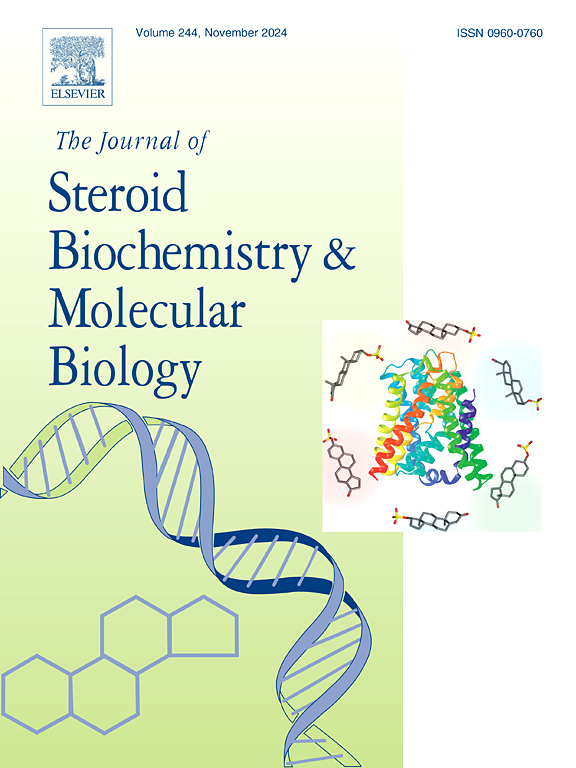1,25(OH)2D3上调线粒体动力学和生物发生以调节麝鼠气味腺的甾体生成
IF 2.5
2区 生物学
Q3 BIOCHEMISTRY & MOLECULAR BIOLOGY
Journal of Steroid Biochemistry and Molecular Biology
Pub Date : 2025-05-20
DOI:10.1016/j.jsbmb.2025.106787
引用次数: 0
摘要
维生素D3在类固醇激素的产生中起着至关重要的调节作用,但具体的机制尚不完全清楚。在本研究中,我们研究了麝鼠在繁殖期和非繁殖期嗅觉腺中维生素D受体(VDR)、维生素D3代谢酶(CYP2R1、CYP27B1和CYP24A1)、线粒体动力学和生物发生(蛋白质和基因)以及类固醇生成酶的表达和分布模式。在繁殖期和非繁殖期,VDR、维生素D3代谢酶、线粒体动力学和生物发生相关蛋白、甾体原酶在气味腺细胞中均有免疫定位,且繁殖期免疫染色较强。嗅觉腺中Cyp27b1、Cyp24a1、Vdr、Mfn1、Opa1、Vdac、Tfam、Pgc1b、Star、Cyp11a1、Cyp17a1和Cyp19a1的mRNA表达量在繁殖期高于非繁殖期。1,25(OH)₂D₃浓度与气味腺体线粒体动力学、生物发生标志基因和甾体生成酶mRNA平均表达量呈正相关。在繁殖季节,气味腺的循环睾酮(T)、17β-雌二醇(E2)和125 (OH)₂D₃的浓度也显著升高。此外,在体外培养的原代气味腺细胞中添加1,25(OH)2D3可提高麝鼠气味腺中线粒体动力学、生物发生相关基因和类固醇生成酶的表达水平。这些结果表明,1,25(OH)₂D₃可能通过上调麝鼠气味腺的线粒体动力学和生物发生来促进类固醇激素的分泌。本文章由计算机程序翻译,如有差异,请以英文原文为准。
1,25(OH)2D3 up-regulated mitochondrial dynamics and biogenesis to modulate steroidogenesis in the scent glands of muskrats (Ondatra zibethicus)
Vitamin D3 plays a crucial regulatory role in steroid hormone production, but the specific mechanism remains not fully understood. In this study, we investigated the expression and distribution patterns of Vitamin D receptor (VDR), vitamin D3 metabolic enzymes (CYP2R1, CYP27B1 and CYP24A1), mitochondrial dynamics and biogenesis (proteins and genes), and steroidogenic enzymes in the scent glands of muskrats during the breeding and non-breeding periods. VDR, vitamin D3 metabolic enzymes, mitochondrial dynamics and biogenesis-related proteins, and steroidogenic enzymes were immunolocalized in the scent glandular cells in both breeding and non-breeding seasons, with stronger immunostaining in the breeding season. The mRNA expression levels of Cyp27b1, Cyp24a1, Vdr, Mfn1, Opa1, Vdac, Tfam, Pgc1b, Star, Cyp11a1, Cyp17a1, and Cyp19a1 were higher in the scent glands during the breeding season than those of the non-breeding season. 1,25(OH)₂D₃ concentration were positively correlated with the mean mRNA expression levels of mitochondrial dynamics and biogenesis marker genes and steroidogenic enzymes in the scent glands. The concentrations of circulating testosterone (T) and 17β-estradiol (E2), and 1,25(OH)₂D₃ of the scent glands were also significantly higher in the breeding season. Additionally, the addition of 1,25(OH)2D3 to the primary scent glandular cells in vitro increased the expression levels of mitochondrial dynamics and biogenesis-related genes and steroidogenic enzymes in the scent glands of muskrats. These findings suggested that 1,25(OH)₂D₃ might promote the secretion of steroid hormones by upregulating the mitochondrial dynamics and biogenesis in the scent glands of muskrats.
求助全文
通过发布文献求助,成功后即可免费获取论文全文。
去求助
来源期刊
CiteScore
8.60
自引率
2.40%
发文量
113
审稿时长
46 days
期刊介绍:
The Journal of Steroid Biochemistry and Molecular Biology is devoted to new experimental and theoretical developments in areas related to steroids including vitamin D, lipids and their metabolomics. The Journal publishes a variety of contributions, including original articles, general and focused reviews, and rapid communications (brief articles of particular interest and clear novelty). Selected cutting-edge topics will be addressed in Special Issues managed by Guest Editors. Special Issues will contain both commissioned reviews and original research papers to provide comprehensive coverage of specific topics, and all submissions will undergo rigorous peer-review prior to publication.

 求助内容:
求助内容: 应助结果提醒方式:
应助结果提醒方式:


